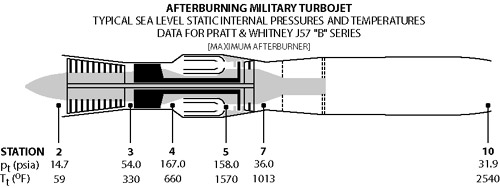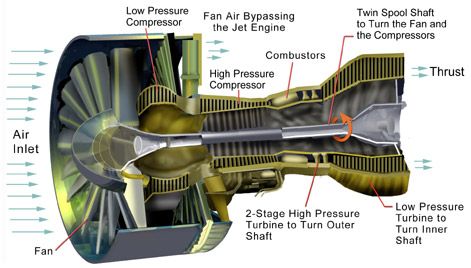I. Introduction to Propulsion
A. Goal: Create a Force to Propel a Vehicle
Two options:
-
Take mass stored in a vehicle and throw it backwards (rocket
propulsion). Use the reaction force to propel the vehicle.
| Propellant |
---> |
burn |
---> |
expand through nozzle |
| (chem. energy) |
|
(thermal energy) |
|
(kinetic energy & momentum) |
-
Seize mass from the surroundings and set the mass in motion
backwards. Use the reaction force to propel vehicle (air-breathing propulsion).
| Continuously: |
a) Draw in air. |
| |
b) Compress it. |
| |
c) Add fuel and burn (convert chemical energy to thermal energy). |
| |
d) Expand through a turbine to drive compressor (extract work). |
| |
e.1) Then expand in a nozzle to convert thermal energy to kinetic energy
& momentum (turbojet). |
| |
e.2) Or expand in a second turbine (extract work), use this to drive a
shaft for a fan (turbofan), or a propeller (turboshaft). The fan or propeller
impart k.e. & mom. to the air. |
Overall goal: take  at
Vo (flight speed), throw it out at Vo + DV
at
Vo (flight speed), throw it out at Vo + DV
Q2 (PDF)
Figure 1.1 Schematics of typical military gas
turbine engine: J57 turbojet with afterburning.
Figure 1.2 A typical high bypass-ratio turbofan (Adapted
from Pratt & Whitney).
For more examples of real world powerplants, refer to Hill, P. and C. Peterson.
Thermodynamics of Propulsion. 2nd Ed. Addison-Wesley, 1991.
B. Performance Parameters
The two performance parameters of greatest interest for a propulsion system
are the force it produces (thrust, T), and the overall efficiency with
which it uses energy to produce this force (hoverall). We will begin by looking
at the production of thrust using the integral form of the momentum theorem. In the second lecture we will discuss the efficiency of propulsion systems.
C.
Propulsion is a systems endeavor
There are a multitude of other factors which a propulsion
engineer must take into account when designing a device including weight, cost,
manufacturability, safety, environmental effects, etc. Thus propulsion is truly
a systems endeavor, requiring knowledge of a variety of disciplines:
| Fluids + thermo + structures + dynamics + controls + chemistry
+ acoustics + … |
 |
We will focus mostly on these two disciplines in the Unified propulsion lectures.
at Vo (flight speed), throw it out at Vo + DV

